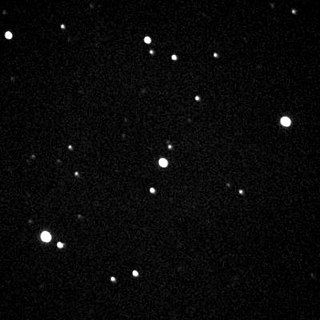
WASP-1 is a metal-rich magnitude 12 star located about 1,300 light-years away in the Andromeda constellation.
WASP-10 is a star in the constellation Pegasus. The SuperWASP project has observed and classified this star as a variable star, perhaps due to the eclipsing planet.
WASP-5 is a magnitude 12 yellow dwarf star located about 910 light-years away in the Phoenix constellation. The star is likely older than Sun, slightly enriched in heavy elements and is rotating rapidly, being spun up by the tides raised by the giant planet on the close orbit.

HD 15082 is a star located roughly 399 light years away in the northern constellation of Andromeda. The star is a Delta Scuti variable and a planetary transit variable. A hot Jupiter type extrasolar planet, named WASP-33b or HD 15082b, orbits this star with an orbital period of 1.22 days. It is the first Delta Scuti variable known to host a planet.
WASP-76, also known as BD+01 316, is a yellow-white main sequence star in the constellation of Pisces. Since 2014, it has had one suspected stellar companion at a projected separation of 85 astronomical units.
HD 146389, is a star with a yellow-white hue in the northern constellation of Hercules. The star was given the formal name Irena by the International Astronomical Union in January 2020. It is invisible to the naked eye with an apparent visual magnitude of 9.4 The star is located at a distance of approximately 446 light years from the Sun based on parallax, but is drifting closer with a radial velocity of −9 km/s. The star is known to host one exoplanet, designated WASP-38b or formally named 'Iztok'.
WASP-48 is a subgiant star about 1400 light-years away. The star is likely older than Sun and slightly depleted in heavy elements. It shows an infrared excess noise of unknown origin, yet has no detectable ultraviolet emissions associated with the starspot activity. The discrepancy may be due to large interstellar absorption of light in interstellar medium for WASP-48. The measurements are compounded by the emission from eclipsing contact binary NSVS-3071474 projected on sky plane nearby, although no true stellar companions were detected by survey in 2015.
WASP-64 is a star about 1200 light-years away. It is a G7 class main-sequence star, orbited by a planet WASP-64b. It is younger than the Sun at 3.6±1.6 billion years, and it has a metal abundance similar to the Sun. The star is rotating rapidly, being spun up by the giant planet in a close orbit.
WASP-41 is a G-type main-sequence star. Its surface temperature is 5450±150 K. WASP-41 is similar to the Sun in its concentration of heavy elements, with a metallicity Fe/H index of −0.080±0.090, but is much younger at an age of 2.289±0.077 billion years. The star does exhibit strong starspot activity, with spots covering 3% of the stellar surface.
WASP-69, also named Wouri, is a K-type main-sequence star 164 light-years away. Its surface temperature is 4782±15 K. WASP-69 is slightly enriched in heavy elements compared to the Sun, with a metallicity Fe/H index of 0.10±0.01, and is much younger than the Sun at 2 billion years. The data regarding starspot activity of WASP-69 are inconclusive, but spot coverage of the photosphere may be very high.
WASP-75 is a F-type main-sequence star about 980 light-years away. The star is much younger than the Sun at approximately 2.9±0.2 billion years. WASP-75 is similar to the Sun in its concentration of heavy elements.
WASP-88 is a F-type main-sequence star. Its surface temperature is 6450±61 K. WASP-88 is similar to the Sun in its concentration of heavy elements, with a metallicity Fe/H index of 0.03±0.04, and is younger at an age of 3.0±1.3 billion years.
WASP-80 is a K-type main-sequence star about 162 light-years away. The star's age is much younger than the Sun's at 1.352±0.222 billion years. WASP-80 is similar to the Sun in concentration of heavy elements, although this measurement is highly uncertain.


